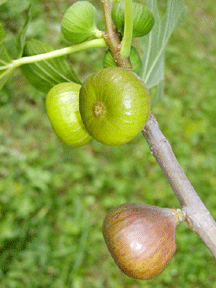
Volume XVII, Issue 24 # June 18 - June 24, 2009 |
 |
by Dr. Frank Gouin
A Resilient Backyard Fruit 
Fig shrubs lost many shoots last winter, but roots survive to sweeten your summer
Figs are a wonderful backyard fruit crop because they do not have to be sprayed and the fruit is sweet and delicious. They are easily preserved by drying, freezing or canning. If you don’t have a fig shrub, plant one this year.
Last year, I harvested a bounty of figs from the three shrubs that grow on the south side of my brick home. However, winter killed back many fig shrubs in parts of southern Maryland.
Anne Arundel County is at the northern limits for growing figs. If your fig shrubs had stems two or more inches in diameter, most likely the top half was killed and you are seeing new growth from the lower half. If you are so fortunate, you have a choice of either cutting the stems at the ground or cutting them just above the most healthy new shoot. Stems that were one inch or less in diameter most likely died back to the ground and should be pruned to the ground.
The roots of fig shrubs were sufficiently protected by the soil and should be sprouting and sending vigorous new shoots. If you allow these new shoots to grow undisturbed, they should produce a late crop of figs by fall. The shoots growing from what’s left of the large stems should produce an earlier crop than those growing from the ground.
Next spring, remember to thin the number of shoots growing from the ground. Two to four new shoots will grow from each stem that was killed. If you allow all of these shoots to grow in 2010, the planting will be too crowded. Before growth starts next spring, dig out the excess plants so that the remaining stems are two to three feet apart. Overcrowding fig stems will result in fewer figs next spring due to excessive competition for light.
Dying the Bay?
Q This morning after a heavy rain, I looked out in my yard and saw standing water the color red. Which shocked me before I remembered the McKinley-sized mountain of mulch the color of Georgia clay dumped in my neighbor’s driveway. The dyed mulch was then heaped on all borders and around trees. So that dye leached into my yard. Can dyed mulch (is it mulch?) be good for the Bay? We live within eyeshot.
–M.L. Faunce, Churchton
A I have been told by the manufacturer, the Bayer Company, that the dye is inert. But should it flow into the Bay, it will add to the turbidity of the water. What I object to is that the raw wood used in making that mulch will rob nitrogen from the soil, causing plants with roots near the surface to starve.